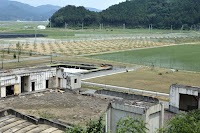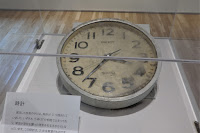Earthquake survivors in northeastern Japan shifting to new phase with refined memories (3)
<Dim, quiet corridor leads visitor to think over memories in hard days>
Up on the third floor, the visitor finds a dimly lit corridor linking the main building to an annex. Poems, essays and sketches that depict occurrences after the disaster are displayed on the walls on both sides, along with a curator's message.
The "weaving our memories" corridor is designed to enable the visitor to think about his or her own respective earthquake memories, while laying them on the scenes described in the pieces.

"We have displayed the pieces so that anyone can imagine the scene of the disaster," said Hiroko Takahashi, the curator, in a recent interview at her office in downtown Ishinomaki.
Among the pieces, a poem, entitled "a cat," says, "Shortly after the disaster, a cat began to appear in our garden from time to time. The cat was named 'cha-cha.' My children so named. I wondered if the cat, amiable, quiet and adorable, is kept by someone. / After the disaster, many pets had been departed from their owners. / The cat was playing with my kids innocently, and the scene made me feel the brightness of life."
The curator herself experienced the strong tremor, when she was at the city office, and quickly evacuated with her colleagues.
An essay, titled "rain boots and a song," says in part, "That day, I put on rain boots. It was not raining, but I went to the nursery school with the light green rain boots. / A big earthquake came. We were taking a nap at that time. The dust came down from the ceiling and so, I tightly closed my eyelids. My younger brother was sleeping beside me. 'Pains in my eyes,' he said. / When we were about to evacuate, my mother came up. After confirming we are all right, she told the staff, 'Evacuate to a higher place. I'll see you later.' Then, she left to return to her work near the sea. / We got into a car together and evacuated to a high school on the hill. / Next day, my mother, covered with mud, came for us. I learned later that she nearly got engulfed with the wave. / We had planned to sing a certain song at our graduation ceremony, and when we sang the song, my mother was shedding tears. So were other mothers. / A few days later, we went home on foot. I realized that the green rain boots which I put on that day had helped me. / 'Mysterious, wasn't it. Just a wonder why you put on the rain boots that day,' my mother said smilingly."
The curator's message, put on the corridor's wall, says, "We live in the natural world that is woven with beautiful curves, and each of us feels in a different way what is important and what is pleasant. Likewise, the shape of our happiness and pains is different. Those who experienced the disaster each have different stories to tell." The display is hoped to help provide a chance for the people concerned to think about "what our living is," says the message.
<Disaster sheds light on small local newspaper's struggle>
Disastrous incidents lead people to think about how their society functions and who or which sector are more in support of social activities.
The covid-19 pandemic gave light to the roles played by essential workers, not just medical staffers but also public-sector workers like garbage collectors. The devastating earthquake also reminded the Japanese of the roles performed by each social sector every day.
Just after the mishap, Ishinomaki people's eyes were drawn to a small local newspaper, Ishinomaki Hibi Shimbun, which kept sending necessary information to affected people seamlessly amid the difficult situation.
The company's printing presses had been destroyed by the tsunami wave, but Ishinomaki Hibi reporters and editors used pens and paper at hand. They came up with handwritten extra editions and put them on the walls at six of the makeshift shelters set up in the city.
The evening newspaper publisher made the handwritten editions for six days from March 12, one day after the disaster, until the restart of its business. The video images of the wrinkled newspapers can be seen at an information site on the compounds of the seaside memorial park.
The March 12 edition, issued on the first day, called the evacuees to "act with correct information." An attached edition, released the following day, listed 80 or so shelters opened in the city, citing the names of the places and the number of evacuees accommodated there, for convenience for those who were looking for the whereabouts of their families and others.
Ishinomaki's population at present comes to approximately 141,400, about 20,000 short of the figure before the disaster.
Since the mishap, 12 years have passed, but the years have not passed uselessly. The period was necessary for the survivors and other people concerned to digest and refine their experience and memories as lessons for the generation to come.
The forthcoming era is expected to be a period for Japanese as a whole to work together and come up with a truly effective anti-disaster system, hard and soft.
With the damaged areas in Ishinomaki almost rehabilitated, bright signs are emerging. giving added hopes for many citizens.
Trees around the entrance to the Kadonowaki Elementary School building had been damaged by the tsunami fire. They had been left unattended for a while, but as the time goes by, new branches started growing from the roots of three trees.
On the top of the Hiyori hill, the place where Kadonowaki Elementary pupils evacuated, Kashima Miko Shrine, a Shinto shrine, attracts worshipers not just on ritual days but also on weekends today.









































